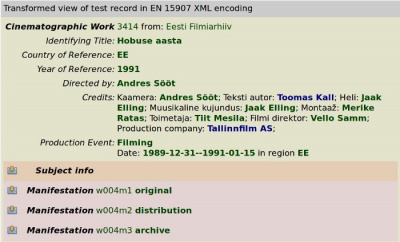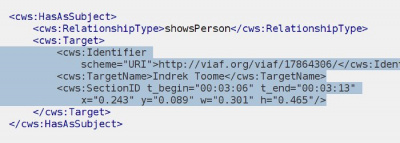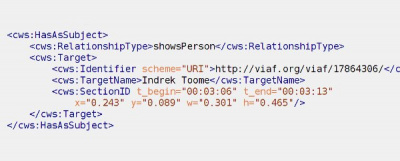Approaching the subject of a film work
From filmstandards.org
From the TC 372 Workshop Compendium
A worked example
Documentary films are typically searched for by subject. While content description and keyword indexing are mainstay procedures in film cataloguing, today's networked environment allows for almost anything to be related to a cinematographic work in the role of subject.
|
<mediaplayer image='http://filmstandards.org/media/hobuse_aasta_frame.png'>http://filmstandards.org/media/hobuse_aasta_clip1_ori.flv</mediaplayer>
|
This is a documentary about events in Estonia before the country gained independence from the Soviet Union in early 1991. The clip contains images from the parliamentary assembly of 26 January, 1990, in which an amendment of the constitution was attempted. The content of this clip clearly focuses on people, in this case on those that represented the leading political class in Estonia until 1990. |

|
We now combine our HasAsSubject references with other forms of subject description, in this case, two synopses taken from published sources, and insert them into a filmographic record for Hobuse Aasta. The transformed view example groups all subject-related statements under a Subject info section (click on the symbol to open). Here is the raw XML code for this example. |

|
Taking a closer look at the Target element in the encoding of the subject reference, we see an identifier that links our filmographic record to an external resource. Since viaf.org can supply information as RDF data structures, this identifier reference can be readily utilised in a Linked Open Data (LOD) environment. The SectionID element has several attributes defined in an extension to the core EN 15907 XML schema. These attributes define a spatio-temporal region in the cinematographic medium to which the subject reference applies. |
